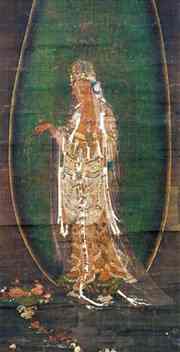A 700-year-old painting of an elegant bodhisattva, which Koreans know from textbooks but very few have seen in person, will be shown to the public for the first time.
 The painting, “Water Moon Avalokiteshvara,” by the monk Hyeheo from the Goryeo period, has traveled from the Sensoji Temple in Tokyo to be included in the largest-ever exhibition of Goryeo Buddhist Paintings. It kicks off today at the National Museum of Korea in Yongsan, Seoul.
The painting, “Water Moon Avalokiteshvara,” by the monk Hyeheo from the Goryeo period, has traveled from the Sensoji Temple in Tokyo to be included in the largest-ever exhibition of Goryeo Buddhist Paintings. It kicks off today at the National Museum of Korea in Yongsan, Seoul.
“Masterpieces of Goryeo Buddhist Painting” features 61 out of the approximately 160 Goryeo Buddhist paintings in existence around the world. The exhibition also has Buddhist paintings from China and Japan from the same period, and some from the early Joseon period for comparison.
“Though Goryeo Buddhist paintings are among the world’s most beautiful religious art, they have not been sufficiently studied, because only a small number of them remain and they are scattered around the world,” Choe Kwang-shik, director of the museum, told reporters. “The paintings have been loaned from 44 institutions in Japan, the United States and Europe, as well as Korea.”
“It was not an easy job to persuade each of the foreign institutions, in particular, some Japanese temples such as Sensoji, which seldom unveil their Goryeo Buddhist paintings even to scholars in their country,” said Min Byoung-chan, chief of the special exhibition team.
Most of the other paintings, including Kshitigarbha from Japan’s Nezu Museum, are being shown for the first time in Korea, the museum said.
Goryeo Buddhist paintings are known for their elegantly flowing lines, generally calm tones, elaborate details, luxurious gold pigments and mystic ambience. “Water Moon Avalokiteshvara” is considered to be the most superb from the period.
The exhibition runs until Nov. 21. Admission is 1,000 won ($0.89) to 3,000 won depending on visitors’ ages.
Author: Moon So-young | Source: JoongAng Daily [October 10, 2010]